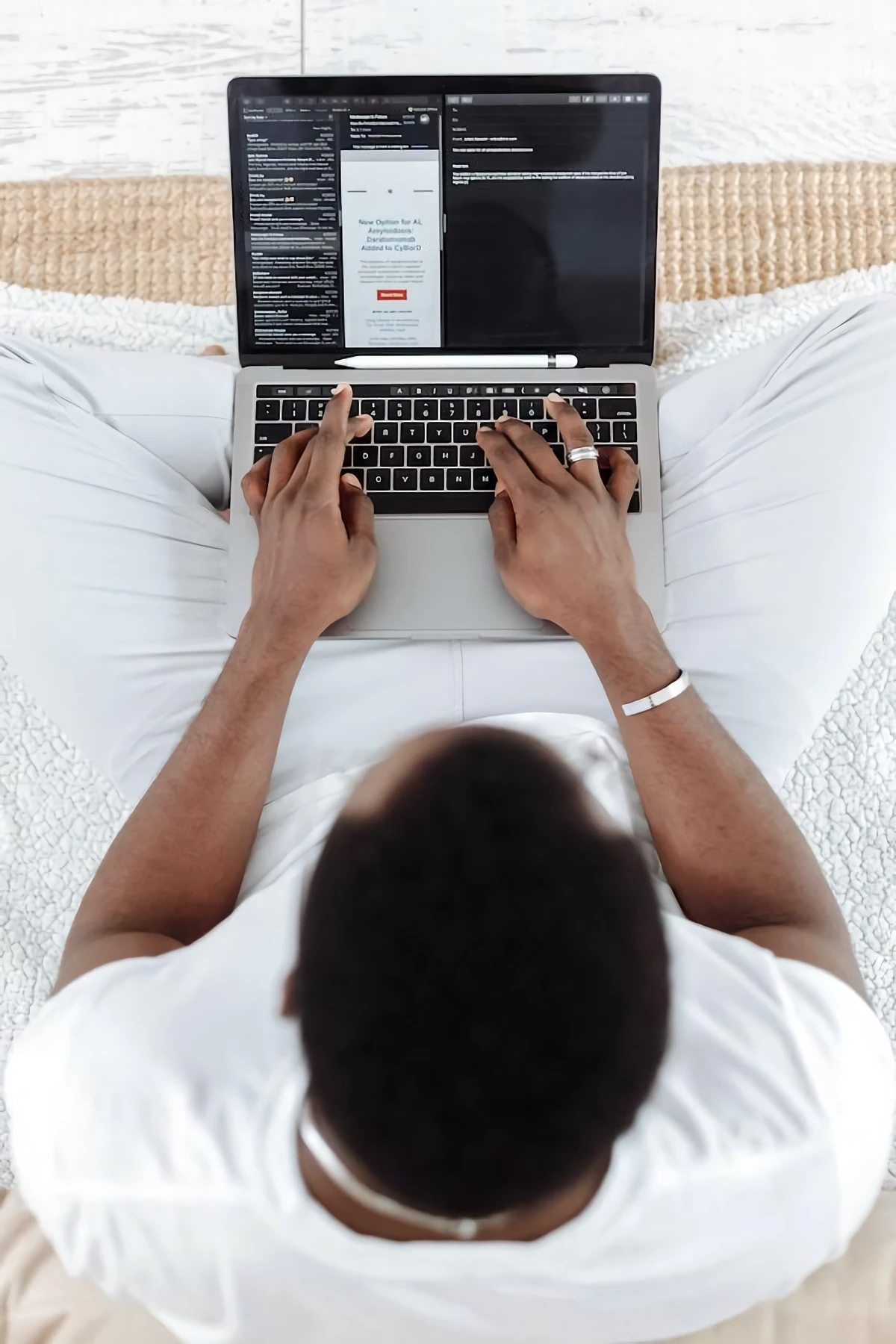My WFH Survival Guide: How to Fix Your Body and Reclaim Your Time
I started working from home well over a decade ago. And honestly? At first, it felt like I’d won the lottery. No commute, a super relaxed dress code (hello, sweatpants), and just me and my work. But after a few months, some not-so-great things started creeping in. A dull ache in my lower back became my constant companion. My favorite jeans felt suspiciously tight. The line between ‘work time’ and ‘home time’ dissolved into one long, blurry day.
In this article
- WFH Traps I Fell Into (And How to Avoid Them)
- Your Workspace is a Health Tool—Treat It Like One
- Build a Daily Structure That Protects Your Sanity
- Movement: Your Secret Weapon Against a Sedentary Day
- A Realistic Approach to WFH Nutrition
- Protecting Your Mind from Stress and Isolation
- If You Only Do ONE Thing Today…
- Inspirational Gallery with Photos
Sound familiar? You’re not alone. The incredible freedom of remote work comes with a hidden price tag if you aren’t paying attention. All those built-in routines from office life—the walk to the train, lunch breaks with coworkers, the simple act of leaving a building—are gone. It’s way too easy to slide into habits that quietly wreck your body and mind. I learned all of this the hard way.
So, this isn’t just another list of quick tips. This is the system I built for myself over years of trial, error, and talking to the pros. It’s designed to help you build a remote work life that isn’t just productive, but genuinely healthy and sustainable for the long haul.

WFH Traps I Fell Into (And How to Avoid Them)
Before we get into the fixes, let’s get real about the common traps. Seeing them written down can be the first step to fixing them. I’ve personally been guilty of all of these:
- The All-Day Pajama Rut: It’s comfy, but it tells your brain you’re never truly ‘on’ or ‘off’. It blurs the lines and can tank your motivation.
- The Kitchen is Too Close: When your biggest stressor is a 10-second walk from a fully stocked pantry, mindless snacking becomes a real problem.
- The Endless Workday: Without a commute to signal the end of the day, it’s easy to find yourself answering ‘just one more email’ at 9 PM. This is a fast track to burnout.
- The Hunchback of Notre Desk: Working from a laptop on a dining table or couch is a recipe for neck, shoulder, and back pain. I call it the ‘temporary’ setup that becomes permanent.
Recognizing these pitfalls is half the battle. Now, let’s build the system to beat them.

Your Workspace is a Health Tool—Treat It Like One
We have to stop thinking of our desk as just a place to put a computer. It’s a tool you use for eight hours a day. If that tool is set up wrong, it will eventually cause injury. It’s not a matter of if, but when. Getting your space right is the most important thing you can do.
This all comes down to ergonomics, which is just a fancy word for fitting the job to the person, not forcing the person to fit the job. A bad setup can lead to compressed spinal discs, strained muscles, and even reduced blood flow that leaves you feeling tired and foggy. A good setup prevents all of that.
The 90-90-90 Rule: Your Posture Blueprint
The golden rule for sitting is what the pros call the 90-90-90 rule. It’s a simple baseline for good posture that makes a world of difference.

Quick Challenge: Sit in your chair right now and check your angles. How do you stack up?
- Ankles: Your feet should be flat on the floor (or a footrest), with your ankles at a comfortable, near-90-degree angle.
- Knees: Your knees should also be bent at roughly 90 degrees. You want a small gap—about two or three fingers’ worth—between the back of your knees and the edge of your chair to avoid pinching nerves.
- Hips: Your hips should be bent at 90 to 100 degrees, with your thighs mostly parallel to the floor. This keeps your pelvis neutral and supports your lower back.
If you’re not hitting those angles, don’t sweat it! Most of us aren’t, especially on a dining chair. I spent my first year using one, and the back pain was… memorable. A proper, adjustable office chair is not a luxury; it’s a long-term health investment. Expect to spend between $200 and $500 for a solid one that will last for years.

Ergonomics on a Budget
I get it—not everyone can drop a few hundred bucks on a chair right now. For years, I helped small businesses get set up without breaking the bank. Here are some cheap but surprisingly effective solutions.
My Budget Ergonomics Starter Kit (Under $100 total):
- For Lumbar Support: If your chair has none, don’t just suffer. A rolled-up towel or a small cushion in the curve of your lower back works wonders. You can also grab a dedicated lumbar pillow for about $25 on Amazon.
- For Your Feet: If your feet dangle, use a footrest. No need for a fancy one; a stack of old textbooks or a sturdy shoebox works perfectly.
- For Your Neck: This is the big one. The top of your screen should be at or just below eye level. Hunching over a laptop is the #1 cause of ‘tech neck’. Grab a laptop stand (around $30) or use a stack of books. Then, you’ll need a separate keyboard and mouse. You can get a decent wireless combo for about $40 at any big-box electronics store.
For under $100, you can eliminate the vast majority of WFH-related pain. It’s the best money you’ll ever spend.
Build a Daily Structure That Protects Your Sanity
Without the built-in structure of an office, you have to create your own. A routine is your best defense against burnout and that work/life blur. Consistency, not perfection, is the goal here.
Bookend Your Day
I teach a concept called ‘bookending’. It just means having a consistent routine to start your day and a totally separate one to end it. This creates clear mental boundaries.
A morning bookend might look like this:
- Wake up at a consistent time.
- Do 15 minutes of light stretching or walk around the block.
- Eat a real breakfast, and please, not at your desk.
- Get dressed. Seriously. Changing out of pajamas signals a mental shift.
- Start work at your set time.
The evening bookend, or ‘shutdown ritual’, is even more critical:
- Set an alarm for 15 minutes before you plan to stop.
- Use that time to tidy your desk and plan tomorrow’s top 3 tasks.
- Close your laptop. Shut it down completely.
- Physically leave your workspace. Go to another room.
- Change your clothes. This signals to your brain that the workday is officially over.
The Magic of Scheduled Breaks
Trying to power through for hours on end is a myth. Your brain needs downtime to stay sharp. The Pomodoro Technique is fantastic for this: you work for a focused 25 minutes, then take a 5-minute break. After four rounds, you take a longer 15-20 minute break. You can find dozens of free timer apps for your phone or computer.
Why does it work? Those short, frequent breaks prevent mental fatigue. And here’s the key: on your 5-minute break, do not check your phone. Get up. Walk around. Stretch. Grab a glass of water. It’s a small change with a massive impact on your afternoon energy levels.
Movement: Your Secret Weapon Against a Sedentary Day
Our bodies were not designed to sit still for eight hours. Even with a perfect desk setup, being sedentary is just plain unhealthy. It slows your metabolism and tightens key muscles. Regular movement isn’t a bonus; it’s a requirement.
Embrace ‘Exercise Snacking’
You don’t need to block out an hour for a full-blown gym session. Instead, try what some call ‘exercise snacking’—doing short bursts of activity throughout the day. The cumulative effect is huge.
- Every Hour: Get up and walk for at least two minutes.
- During Phone Calls: Stand up and pace.
- While a File Loads: Do 10 bodyweight squats or 15 calf raises.
My Go-To 5-Minute Break Routine: When my Pomodoro timer goes off, I often do this exact circuit. It takes less than five minutes and resets my body and mind.
- 60-second plank
- 15 bodyweight squats
- 15 calf raises
- Stretch whatever feels tight for the last 2 minutes (usually my neck and shoulders)
Setting Up for At-Home Workouts
If you do want to get in a more structured workout, you don’t need a ton of gear. I’ve trained clients in tiny apartments with just a few key items.
- Bodyweight: Free and effective. Squats, lunges, push-ups, and planks are the foundation of a great workout.
- Resistance Bands: A set of these will run you about $20-$30. They’re amazing, versatile, and take up zero space.
- Adjustable Dumbbells: If you have the budget (they can range from $150 to $400+) and space, these are a fantastic investment for building strength, replacing an entire rack of weights.
Heads up! A quick safety warning: Form is ALWAYS more important than how much you lift or how many reps you do. I’ve seen more people hurt their lower back with bad squat form at home than anywhere else. If you’re new to an exercise, please watch a few videos from a certified trainer on YouTube.
Quick Squat Form Guide:
- Stand with your feet about shoulder-width apart, toes pointing slightly out.
- Keep your chest up and your back straight as you begin.
- Lower yourself down as if you’re sitting back in a chair, aiming to get your thighs parallel to the floor. Drive back up through your heels.
A Realistic Approach to WFH Nutrition
When the kitchen is your closest coworker, mindless eating is a real danger. The secret isn’t more willpower; it’s controlling your environment.
Stock Your Kitchen for Success
If your cupboards are filled with junk food, you’re going to eat junk food. It’s that simple. The easiest way to eat healthy is to make it the most convenient option. Your grocery list should be packed with whole foods like lean proteins (chicken, beans, eggs), tons of vegetables, fruits, healthy fats (avocado, nuts), and complex carbs (quinoa, oats, sweet potatoes).
My 90-Minute Sunday Meal Prep
You don’t need to spend all day cooking. A little prep goes a long way. Here’s my personal system, which takes about 90 minutes every Sunday afternoon:
While I preheat the oven, I put 2 cups of quinoa in the rice cooker. As that cooks, I chop up a ton of veggies—broccoli, bell peppers, onions—toss them in olive oil and seasoning, and put them in the oven to roast. Then, I’ll grill or bake four or five chicken breasts. Boom. In the time it takes to watch a movie, I have a cooked grain, roasted veggies, and a protein source ready in the fridge. I can throw together a healthy, filling lunch bowl or salad in less than three minutes all week long.
The Hydration Rule
Your brain often mistakes thirst for hunger. Before you reach for a snack, try this: drink a full glass of water and wait 10 minutes. More often than not, the craving will vanish. Keep a big water bottle on your desk as a visual reminder. Aiming for two to three liters a day is a great goal.
Protecting Your Mind from Stress and Isolation
Remote work health isn’t just physical. The lack of casual social interaction and the blurred work/life boundaries can take a serious mental toll.
Be Intentional About Human Connection
You have to actively schedule social time. Instant messages don’t count.
- Schedule Virtual Coffees: Once a week, have a 15-minute video call with a colleague where the only rule is no talking about work.
- Find a ‘Third Place’: Join an online or local group for a hobby. Having a space that isn’t home or work is vital.
- Talk to Actual People: Call a friend on your lunch break. Make small talk with the cashier at the grocery store. These little interactions add up.
Manage Your Stress Response
Your shutdown ritual is your first line of defense here. But when you feel that wave of stress hit mid-day, try ‘box breathing’. It’s a simple technique used by everyone from surgeons to elite soldiers to calm the nervous system.
- Breathe in slowly through your nose for a count of four.
- Hold your breath for a count of four.
- Exhale slowly through your mouth for a count of four.
- Hold at the bottom for a count of four.
- Repeat for one or two minutes. It really works.
A Quick Disclaimer: I’m an expert in workplace wellness, but I’m not a mental health professional. These are strategies for everyday stress. If you’re dealing with persistent anxiety, depression, or severe burnout, please reach out to a licensed therapist. It’s a sign of strength, not weakness.
If You Only Do ONE Thing Today…
Feeling overwhelmed by all this? I get it. If you’re going to make just one change today, do this: put your laptop on a stack of books and find a spare keyboard and mouse. Raising your screen to eye level is the fastest, cheapest, and most impactful fix you can make. You’ll feel the difference in your neck and shoulders by the end of the day.
Building a healthy WFH life isn’t about one giant, dramatic change. It’s about building a system of small, smart habits. Be patient. Start with one thing. Master it, then add another. Over time, these tiny actions will build a powerful, sustainable foundation for a long and healthy career from home.
Inspirational Gallery with Photos
The Ergonomic Audit: Don’t just settle for ‘good enough.’ Your chair is your cockpit for 8+ hours a day. An investment in a quality ergonomic chair like a Steelcase Gesture or a Herman Miller Aeron isn’t a luxury; it’s a long-term health strategy. Look for adjustable lumbar support, armrests that align with your desk height, and a seat depth that leaves two to three fingers of space behind your knees. Your future self will thank you.
A 2017 study found that strategically placed indoor plants can reduce stress and increase productivity by up to 15%.
It’s more than just aesthetics. This concept, known as biophilic design, taps into our innate connection with nature. A simple snake plant or a pothos on your desk doesn’t just purify the air; it can genuinely improve your focus and mood. They are low-maintenance options perfect for a workspace.
Is your screen hurting your eyes?
It’s likely digital eye strain. Your screen should be at arm’s length, with the top of the monitor at or slightly below eye level. Combat the fatigue with the 20-20-20 rule: every 20 minutes, look at something 20 feet away for at least 20 seconds. Also, consider enabling your device’s night mode or using an app like f.lux to reduce blue light exposure throughout the day, not just at night.
- Reduces physical stagnation and back pain.
- Improves circulation and focus.
- Burns more calories than sitting.
The secret? Alternating between sitting and standing. A full standing desk is great, but a converter like those from Vari allows you to transform any surface into a sit-stand station, offering flexibility without replacing your entire desk setup.
Reclaim your commute, even if it’s just 15 minutes. Before starting work, don’t just roll from bed to desk. Try one of these ‘fake commutes’ to signal to your brain that the workday is beginning:
- A short walk around the block, rain or shine.
- Stretching for 10 minutes while listening to a specific podcast.
- Brewing a special coffee or tea with mindful intention, away from your desk.
According to a survey by Statista, 41% of remote workers report that ‘unplugging after work’ is their biggest struggle.
The Power of Scent Zoning: Your brain forms powerful connections between smell and context. Use this to your advantage. A diffuser with an energizing scent like peppermint or lemon essential oil can help you focus during work hours. At 5 PM, switch to a calming lavender or chamomile blend. This simple sensory cue helps create a powerful mental boundary between ‘work mode’ and ‘relaxation mode’.
Budget Ergonomics: You don’t need a four-figure budget to save your back. A rolled-up towel or a small cushion can provide excellent lumbar support. Stack a few sturdy books or a ream of printer paper under your laptop to raise the screen to eye level. The goal is proper alignment, and you can often achieve it with items you already own.
Smart Snacking Station: The trap of the nearby kitchen is real. Instead of relying on willpower alone, curate a dedicated work-snack station at your desk. Stock a small caddy with pre-portioned nuts, healthy protein bars like RXBARs, and a large water bottle. By making the healthy choice the easy choice, you short-circuit the impulse to wander to the pantry for chips.
Tech for Focus: The unstructured nature of WFH can make deep work feel impossible. Embrace the Pomodoro Technique—25 minutes of focused work followed by a 5-minute break. Apps like Forest or Be Focused automate the timing and can even block distracting websites. It’s a structured approach to managing your own time and attention, recreating the focus of an office environment.










